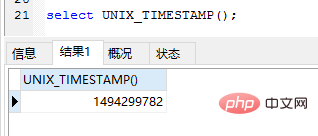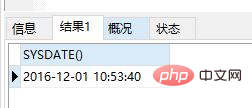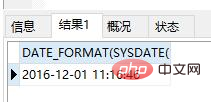Summary of date and time types and formatting methods in MySQL
This article brings you relevant knowledge about mysql. It mainly introduces the date and time types and formatting methods in MySQL. Several commonly used time types in MySQL are: date, datetime , time, year, timestamp, let’s take a look at it, I hope it will be helpful to everyone.

Recommended learning: mysql video tutorial
[1] Date and time types in MySQL
MySQL Several commonly used time types are: date, datetime, time, year, timestamp
| Data type | Occupies the smallest number of bytes | Value | Maximum value | A zero value means |
|---|---|---|---|---|
| date | 4 | 1000-01-01 | 9999-12-31 | 0000-00-00 |
| datetime | 8 | 1000-01-01 00:00:00 | 9999-12-31 23:59:59 | 0000-00-00 00:00: 00 |
| timestamp | 4 | 19700101080001 | Sometime in 2038 | 0000000000000000 |
| time | 3 | -838:59:59 | 838:59:59 | 00:00:00 |
| year | 1 | 1901 | 2155 | 0000 |
Detailed explanation
-
datetime: Time date type, the format is YYYY-mm-dd HH: ii:ss, the range is from 1000 to 9999. But there is a zero value, 0000-00-00 00:00:00; -
date: Date is the date part of datetime; -
time: Time (segment), between a specified interval, from - time to time (represented by negative time); -
timestamp: Timestamp, not a conventional time Stamp (such as: 14253685), the range is '1970-01-01 00:00:00' to 2037. The format is YYYY-mm-dd HH:ii:ss, The format is completely consistent with datetime; -
year: yy and yyyy, the range of yyyy is 1901-2155 , the range of yy is 1970-2069.
Two-digit year (00-69 means 2000-2069, 70-99 means 1970~1999). When the application only needs to record the year, year saves more space than date
SQL statement example
create table my_date( d1 datetime, d2 date, d3 time, d4 timestamp, d5 year )charset utf8; desc my_date
As shown in the figure below: year defaults to 4 digits, that is, YYYY; timestamp cannot be empty, and there is The default value is to refresh this data column when creating new records and modifying existing records.

Insert several pieces of data as follows and do a difference analysis on time:
insert into my_date VALUES('2015-09-28 11:50:36','2015-09-28','11:50:54','2015-09-28 11:51:08','2015'); insert into my_date VALUES('2015-09-28 11:50:36','2015-09-28','-11:50:54','2015-09-28 11:51:08','2015');-- -11 insert into my_date VALUES('2015-09-28 11:50:36','2015-09-28','-211:50:54','2015-09-28 11:51:08','2015');-- -2 11 insert into my_date VALUES('2015-09-28 11:50:36','2015-09-28','-2 11:50:54','2015-09-28 11:51:08','2015');-- -2过去两天 #year用69标识-2069 insert into my_date VALUES('2015-09-28 11:50:36','2015-09-28','11:50:54','2015-09-28 11:51:08','69');-- 69 #year用70标识-1970 insert into my_date VALUES('2015-09-28 11:50:36','2015-09-28','11:50:54','2015-09-28 11:51:08','70');-- 70


timestamp field
By default, as long as the current record is updated, this field will be automatically updated to the current time.
update my_date set d1 = SYSDATE() where d5=69; select * from my_date

So can MySQL get the real timestamp? sure!
select UNIX_TIMESTAMP();

Test Example
4.1 Query the current time
SELECT SYSDATE() from dual;

4.2 Insert the current time into the above types of columns
insert INTO `user` (name,number,date,datetime,timestamp,time,year) VALUES ( 'Loum',3,SYSDATE(),SYSDATE(),SYSDATE(),SYSDATE(),2016 );

4.3 The length bit of datetime type in mysql The number
is as follows. Usually the length of the datetime type in our MySQL is designed to be 0 by default:
`work_time` datetime(0) DEFAULT NULL COMMENT '清收时间',
At this time, the insertion time is usually what we often see: 2020-08- 29 12:52:16 format. But what if n in datetime(n) is not 0?
`work_time` datetime(2) DEFAULT NULL COMMENT '清收时间', # datetime(n)中的n最大值为6 `work_time` datetime(6) DEFAULT NULL COMMENT '清收时间',
At this time, it will be displayed as follows in MySQL:
2020-08-29 12:52:16.01
2020-08-29 12:52:16.014057
You will find that there is a decimal point at the end and the numbers after the decimal point will correspond to the corresponding digits - this is called nanoseconds.
The summary is as follows:
date: only date, no time;datetime: With time and date;time: Only time, accurate to minutes and seconds;timestamp: Timestamp, accurate to minutes Seconds;year: year, such as 2002, if written as 2002-01-15, calculation will be performed, and the inserted result will be 1986
[2 】Date time type formatting
DATE_FORMAT( ) function
You can use the date_format( ) function to convert time.
SELECT DATE_FORMAT(SYSDATE(),'%Y-%m-%d %H:%i:%s') from dual;

date_format( ) 转换格式
| 格式 | 描述 |
|---|---|
| %a | 缩写星期名 |
| %b | 缩写月名 |
| %c | 月,数值 |
| %D | 带有英文前缀的月中的天 |
| %d | 月的天,数值(00-31) |
| %e | 月的天,数值(0-31) |
| %f | 微秒 |
| %H | 小时 (00-23) |
| %h | 小时 (01-12) |
| %I | 小时 (01-12) |
| %i | 分钟,数值(00-59) |
| %j | 年的天 (001-366) |
| %k | 小时 (0-23) |
| %l | 小时 (1-12) |
| %M | 月名 |
| %m | 月,数值(00-12) |
| %p | AM 或 PM |
| %r | 时间,12-小时(hh:mm:ss AM 或 PM) |
| %S | 秒(00-59) |
| %s | 秒(00-59) |
| %T | 时间, 24-小时 (hh:mm:ss) |
| %U | 周 (00-53) 星期日是一周的第一天 |
| %u | 周 (00-53) 星期一是一周的第一天 |
| %V | 周 (01-53) 星期日是一周的第一天,与 %X 使用 |
| %v | 周 (01-53) 星期一是一周的第一天,与 %x 使用 |
| %W | 星期名 |
| %w | 周的天 (0=星期日, 6=星期六) |
| %X | 年,其中的星期日是周的第一天,4 位,与 %V 使用 |
| %x | 年,其中的星期一是周的第一天,4 位,与 %v 使用 |
| %Y | 年,4 位 |
| %y | 年,2 位 |
str_to_date()函数
字符串转换为date:
str_to_date( '2016-12-15 16:48:40', '%Y-%m-%d %H:%i:%S' )
推荐学习:mysql视频教程
The above is the detailed content of Summary of date and time types and formatting methods in MySQL. For more information, please follow other related articles on the PHP Chinese website!

Hot AI Tools

Undresser.AI Undress
AI-powered app for creating realistic nude photos

AI Clothes Remover
Online AI tool for removing clothes from photos.

Undress AI Tool
Undress images for free

Clothoff.io
AI clothes remover

Video Face Swap
Swap faces in any video effortlessly with our completely free AI face swap tool!

Hot Article

Hot Tools

Notepad++7.3.1
Easy-to-use and free code editor

SublimeText3 Chinese version
Chinese version, very easy to use

Zend Studio 13.0.1
Powerful PHP integrated development environment

Dreamweaver CS6
Visual web development tools

SublimeText3 Mac version
God-level code editing software (SublimeText3)

Hot Topics
 MySQL's Role: Databases in Web Applications
Apr 17, 2025 am 12:23 AM
MySQL's Role: Databases in Web Applications
Apr 17, 2025 am 12:23 AM
The main role of MySQL in web applications is to store and manage data. 1.MySQL efficiently processes user information, product catalogs, transaction records and other data. 2. Through SQL query, developers can extract information from the database to generate dynamic content. 3.MySQL works based on the client-server model to ensure acceptable query speed.
 How to start mysql by docker
Apr 15, 2025 pm 12:09 PM
How to start mysql by docker
Apr 15, 2025 pm 12:09 PM
The process of starting MySQL in Docker consists of the following steps: Pull the MySQL image to create and start the container, set the root user password, and map the port verification connection Create the database and the user grants all permissions to the database
 Laravel Introduction Example
Apr 18, 2025 pm 12:45 PM
Laravel Introduction Example
Apr 18, 2025 pm 12:45 PM
Laravel is a PHP framework for easy building of web applications. It provides a range of powerful features including: Installation: Install the Laravel CLI globally with Composer and create applications in the project directory. Routing: Define the relationship between the URL and the handler in routes/web.php. View: Create a view in resources/views to render the application's interface. Database Integration: Provides out-of-the-box integration with databases such as MySQL and uses migration to create and modify tables. Model and Controller: The model represents the database entity and the controller processes HTTP requests.
 Solve database connection problem: a practical case of using minii/db library
Apr 18, 2025 am 07:09 AM
Solve database connection problem: a practical case of using minii/db library
Apr 18, 2025 am 07:09 AM
I encountered a tricky problem when developing a small application: the need to quickly integrate a lightweight database operation library. After trying multiple libraries, I found that they either have too much functionality or are not very compatible. Eventually, I found minii/db, a simplified version based on Yii2 that solved my problem perfectly.
 How to install mysql in centos7
Apr 14, 2025 pm 08:30 PM
How to install mysql in centos7
Apr 14, 2025 pm 08:30 PM
The key to installing MySQL elegantly is to add the official MySQL repository. The specific steps are as follows: Download the MySQL official GPG key to prevent phishing attacks. Add MySQL repository file: rpm -Uvh https://dev.mysql.com/get/mysql80-community-release-el7-3.noarch.rpm Update yum repository cache: yum update installation MySQL: yum install mysql-server startup MySQL service: systemctl start mysqld set up booting
 Centos install mysql
Apr 14, 2025 pm 08:09 PM
Centos install mysql
Apr 14, 2025 pm 08:09 PM
Installing MySQL on CentOS involves the following steps: Adding the appropriate MySQL yum source. Execute the yum install mysql-server command to install the MySQL server. Use the mysql_secure_installation command to make security settings, such as setting the root user password. Customize the MySQL configuration file as needed. Tune MySQL parameters and optimize databases for performance.
 Laravel framework installation method
Apr 18, 2025 pm 12:54 PM
Laravel framework installation method
Apr 18, 2025 pm 12:54 PM
Article summary: This article provides detailed step-by-step instructions to guide readers on how to easily install the Laravel framework. Laravel is a powerful PHP framework that speeds up the development process of web applications. This tutorial covers the installation process from system requirements to configuring databases and setting up routing. By following these steps, readers can quickly and efficiently lay a solid foundation for their Laravel project.
 MySQL vs. Other Programming Languages: A Comparison
Apr 19, 2025 am 12:22 AM
MySQL vs. Other Programming Languages: A Comparison
Apr 19, 2025 am 12:22 AM
Compared with other programming languages, MySQL is mainly used to store and manage data, while other languages such as Python, Java, and C are used for logical processing and application development. MySQL is known for its high performance, scalability and cross-platform support, suitable for data management needs, while other languages have advantages in their respective fields such as data analytics, enterprise applications, and system programming.






